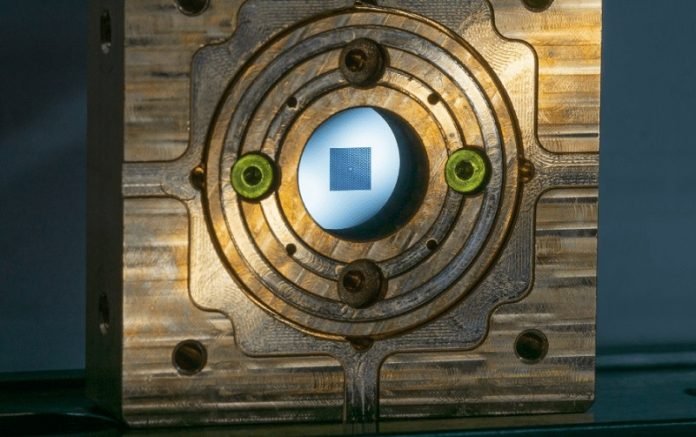
In the depths of the University of Copenhagen’s Niels Bohr Institute, beneath the former office of renowned physicist Niels Bohr, a new quantum technology is taking shape.
Researchers there have developed a groundbreaking “quantum drum” that can store and transmit data with unprecedented security and speed, potentially revolutionizing how we use the internet.
This quantum drum is not your typical musical instrument.
It’s a small, delicate membrane made from a ceramic, glass-like material, dotted with precisely patterned holes.
When struck by laser light, this drum vibrates in such a way that quantum mechanics, the laws governing the smallest particles in the universe, come into play.
These vibrations can store data transmitted as light, converting it into sound waves that are preserved until needed again.
Here’s how it works: an auxiliary laser first calms any natural vibrations from the environment, setting the drum into its preferred rhythm or “resonance.”
This makes the drum extremely sensitive to incoming data signals, which it can capture with quantum-level precision.
Once the data is stored as sonic vibrations, another laser retrieves it, converting it back into a light signal that carries the original information forward.
This method, recently detailed in the journal Physical Review Letters, could solve major challenges faced by current and future quantum networks.
Quantum computers, which operate on principles fundamentally different from classical computers, can process vast amounts of data at incredible speeds thanks to properties called superposition and entanglement.
Superposition allows quantum bits (qubits) to be in multiple states simultaneously, while entanglement links particles across distances, meaning the state of one instantly influences another.
However, transmitting data from quantum computers over long distances, such as through fiber-optic cables, is problematic.
The signal tends to get lost in noise, a problem exacerbated the longer the transmission line.
Traditional internet infrastructure deals with noise by boosting signals at intervals, a method unsuitable for quantum data, which cannot be amplified without being disturbed.
Enter the quantum drum, which has shown great promise in receiving, storing, and re-sending quantum data without loss or corruption.
By potentially acting as relay points along data transmission routes, these drums could extend the range and integrity of quantum communications, ensuring the data remains in its quantum state without converting it into classical binary signals, which are susceptible to cyberattacks.
The implications are vast. Secure quantum networks could support not only ultra-fast computing but also nearly unbreakable encryption.
Since observing any quantum data automatically alters it, any interception attempt would be instantly detectable.
The research team is optimistic about the future applications of their discovery. They envision the quantum drum playing a key role in a new type of internet—a quantum internet—that promises faster, more secure communications across the globe.
Moreover, the flexibility of the quantum drum, capable of interacting with all light frequencies, adds to its potential.
This adaptability could allow it to integrate seamlessly with existing technologies, bridging the gap between today’s internet and the quantum networks of tomorrow.
As quantum computing and communication technologies continue to evolve, the quantum drum may soon become an essential component of global communications, acting as a sort of quantum RAM, a temporary storage for the rapid and secure transfer of information across the quantum internet.



